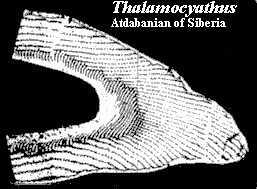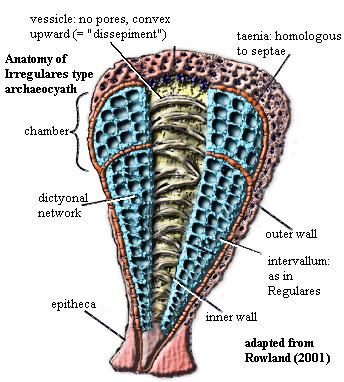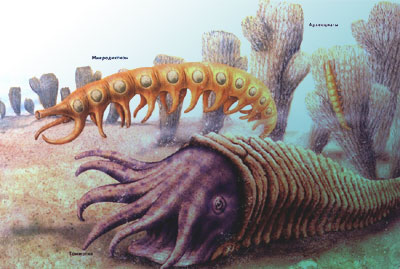Anatomy
Ecology
Phylogeny and Diversity
| Archaeocyatha | ||
| Porifera | Archaeocyatha - 1 |
| Metazoa | Metazoa | Metazoa | ||||
| Time |
|
Porifera
├─Archaeocyatha
│ ├─Ajacicyathida
│ └─Irregulares
└─┬─Stromatoporoidea
└─┬─Calcarea
└─┬─Hexactinellida
└─┬─Demospongiae
│ ├─Tetractinomorpha
│ └─Ceractinomorpha
└─┬─Homoscleromorpha
└─Eumetazoa
|
Introduction Anatomy Ecology Phylogeny and Diversity |
 The Archaeocyatha are chiefly remembered for being the first Metazoan reef builders. They flourished briefly during the Terreneuvian and Cambrian Epoch 2, then declined drastically. A few survivors straggling on until the end of the Cambrian. Archaeocyaths had calcareous skeletons and lived attached to the sea-floor. They sometimes formed colonies, but were more often solitary members of reef communities actually dominated by mineralizing bacteria.
The Archaeocyatha are chiefly remembered for being the first Metazoan reef builders. They flourished briefly during the Terreneuvian and Cambrian Epoch 2, then declined drastically. A few survivors straggling on until the end of the Cambrian. Archaeocyaths had calcareous skeletons and lived attached to the sea-floor. They sometimes formed colonies, but were more often solitary members of reef communities actually dominated by mineralizing bacteria.
After a long history of phylogenetic uncertainty, the present consensus is that they were sponges. However, their placement as stem sponges is essentially arbitrary. The archaeocyath body typically consisted of two nested, perforate cones connected by a series of septa. Water flowed through the pores, into the space between the walls, and ultimately out through the central cavity. Work on the biomechanics of water flow through this structure suggests that archaeocyaths operated much like other sponges.
A word on nomenclature. In the days before Google, it didn't matter much how one turned nouns into adjectives. Now it does. About half the literature uses "archaeocyathan" as the word meaning "of or pertaining to the Archaeocyatha." We use "archaeocyath" as both the generic noun and the as the adjective. However, if you do any searching, try both. We missed some good sources on the first pass.
Special Credit: special thanks to Prof. Carlos M. da Silva of the Universidade de Lisboa, for posting really good material on archaeocyaths; and to Lângia Colli Montresor, Universidade Federal de Minas Gerais, for help with the translation.
Special Discredit: a raised eyebrow goes to Kevin Zelnio and Christopher Taylor for their song Receptaculites -- surely the world's finest musical exposition of archaeocyath phylogeny. Kevin's sensitive interpretation of this moving schwammlied may be found here, a perfomance marred only slightly by the words, music, execution, etc. Unfortunately the guitar accompaniment also seems to have suffered some sort of diagenetic alteration...
 Morphology: The essential body plan of the Archaeocyatha looks like pair of porous ice-cream cones -- or dunce hats -- one inside the other, forming inner and outer walls. The space between the calcareous cones is the intervallum. Both the inner and outer walls are porous. The two walls are joined by radially-arranged partitions (septae) which frequently look quite a lot like the septae of modern corals. Benton & Harper (1997); Rowland (2001).
Morphology: The essential body plan of the Archaeocyatha looks like pair of porous ice-cream cones -- or dunce hats -- one inside the other, forming inner and outer walls. The space between the calcareous cones is the intervallum. Both the inner and outer walls are porous. The two walls are joined by radially-arranged partitions (septae) which frequently look quite a lot like the septae of modern corals. Benton & Harper (1997); Rowland (2001).
This model implies an inverted conical shape, which is common, but archaeocyaths are also frequently cylindrical or even discoid. Rowland 2001). The size of archaeocyaths varies, normally between 1 - 2.5 cm in diameter and 8-15 cm high. However, giants species have also been found, 30 cm tall and about 60 cm in diameter.
Exoskeleton and Outer Wall: The archaeocyath skeleton was calcareous; but, beyond that, things get a bit hazy.Some writers assert that this was a high-magnesium sort of calcite. Rowland (2001). Others observe that their fossils were extensively recrystallized, dolomatized (magnesium substituted for some of the calcium), or silicified during fossilization. Álvaro et al. (2002). In any event the skeleton was basically carbonate, not silicate.
The inner and outer walls are both extensively perforated by pores. Benton & Harper (1997). The pores are typically smaller in the outer wall, as in sponges. The outer wall may include outgrowths of various kinds (Rowland, 2001), e.g. tersoid (branches) or rhizoid (anchored to substrate).
Intervallum: The space between the inner and outer walls, the intervallum, is partitioned by a series of thin walls into hundreds of tiny, featureless compartments -- like an apartment in Moscow, only with better plumbing. The longitudinal walls are referred to as septae. Transverse (horizontal) walls, if present, are tabulae; and the individual compartments are loculi. These internal partitions are less porous than the walls, and sometimes lack pores altogether. Benton & Harper (1997); Rowland (2001).
Other structures occasionally found in this anatomical region include upwardly curved domed plates. These have been referred to as dissepiments. That term is now deprecated, by some, in favor of vesicles, in order to conform to sponge terminology. When present, dissepiments/vesicles lack pores and probably function as structural framing, as opposed to the drywall partitions created by septae and tabulae. One family of archaeocyaths, the Dokidocyathidae, also has spicule-like bars.
 Inner wall and Central Cavity: The inner wall often has larger pores, like the openings into the spongocoel of more conventional sponges. The vesicles may extend into central cavity. The upper end of the central cavity is open to the environment, and is 1-5 cm in diameter in at the wide end. The bottom narrows to a rounded base, and the entire system is attached to the substrate through an epithecum of uncertain composition and variable morphology. Benton & Harper (1997); Rowland (2001).
Inner wall and Central Cavity: The inner wall often has larger pores, like the openings into the spongocoel of more conventional sponges. The vesicles may extend into central cavity. The upper end of the central cavity is open to the environment, and is 1-5 cm in diameter in at the wide end. The bottom narrows to a rounded base, and the entire system is attached to the substrate through an epithecum of uncertain composition and variable morphology. Benton & Harper (1997); Rowland (2001).
Functional Morphology: The current take on archaeocyath functional anatomy is that they processed sea water in the same manner as other sponges. That is, water entered through the pores in the outer wall, bacteria and detritus were absorbed by choanocytes or equivalent) as the water flowed through the intervallum, and waste was discharged through the central cavity. Rowland (2001).
Environment: The Archaeocyatha were very common in tropical, shallow-water marine environments, almost always on carbonate substrates. Their ideal environment is reconstructed as being a stromatolite-covered carbonate shelf in a warm (~25° C.), open sea at a depth of 20-30 m, in water of moderate energy and high oxygen content. Isolated, solitary archaeocyaths occurred at paleodepths up to almost 100 m, but none deeper. As far as is known, all archaeocyaths were fully marine.
As mentioned above, some archaeocyaths were reef-builders. Benton & Harper (1997) observe that these reefs were "not very impressive;" but they're British (Benton & Harper, not the reefs), so it's hard to tell if this means anything. The archaeocyath reef was generally a mound no more than 3 m thick and 10 or 30 m in diameter. Some (even non-British) paleobiologists are so disdainful of these structures that they refer to them as "stromatolitic-archaeocyath build-ups," preferring to resort to awkward circumlocution rather than dignify these little complexes with the term "reef." Benton & Harper (1997); Rowland (2001); Álvaro et al. (2002).
 Distribution:Archaeocyaths were nearly ubiquitous in tropical regions during most of Cambrian Epoch 2. Wood (1998). So, for example, they were common in East Gondwana (Australia, East Antarctica), West Gondwana (Spain, France), and both coasts of Laurentia (eastern Canada, Nevada). See, e.g., Rowland (2001); Álvaro et al. (2002); Corsetti & Kaufman (2003); Meert & Lieberman (2004); Wrona (2004).
Distribution:Archaeocyaths were nearly ubiquitous in tropical regions during most of Cambrian Epoch 2. Wood (1998). So, for example, they were common in East Gondwana (Australia, East Antarctica), West Gondwana (Spain, France), and both coasts of Laurentia (eastern Canada, Nevada). See, e.g., Rowland (2001); Álvaro et al. (2002); Corsetti & Kaufman (2003); Meert & Lieberman (2004); Wrona (2004).
Growth Habit: Despite their fame as early reef builders, archaeocyaths were more often solitary, and most of the actual building was done by calcareous bacteria in the surrounding stromatolite. In the nature of things, sponges cannot live too densely. They are extremely efficient at sucking up water with bacteria and spraying out water without bacteria. A really large growth of sponges would get in the way of its own exhaust stream and starve to death.
Archaeocyaths early exploited cryptic habitats -- in cavities and hollows below the bacterial mat. Wood (1998). One wonders what this may have contributed to the development of burrowing organisms and the eventual destruction of the firm, bacterial carpeting that covered the typical Proterozoic and Early Cambrian sea bottom within the photic zone.
 |
| Ethmophyllum whitneyi. Laurentia, Botomian age. Height about 2.5 cm. Moore et al. 1952) |
Associations: Archaeocyaths first came to prominence in the Tommotian (Cambrian II), before the trilobites. Even at that time, the archaeocyaths were associated with other animals, i.e. the "small shelly fauna" which were almost all the fauna there were at the time. Maloof et al. 2006). As other potential associates became available over the later Early Cambrian (Atdabanian and Botomian), they were duly associated. Thus, in due course, archaeocyaths are found together with chancelloriids, calcareous sponges, stromatoporoids, hyoliths, trilobites, lingulid brachiopods and assorted echinoderms. Wood (1998); Álvaro et al. (2002); Müller et al. (2007); Sperling et al. (2006). Indeed, many of these associations were unusually close, in that the other organisms are found physically attached to the archaeocyaths.
Image credit: Tommotian community reconstruction from История нашей планеты. Note: Russian-language web sites have an enormous amount of information on archaeocyaths, possibly more than the rest of the WWW put together. Even if (like us) you don't read Russian, run an image search on Археоциаты.